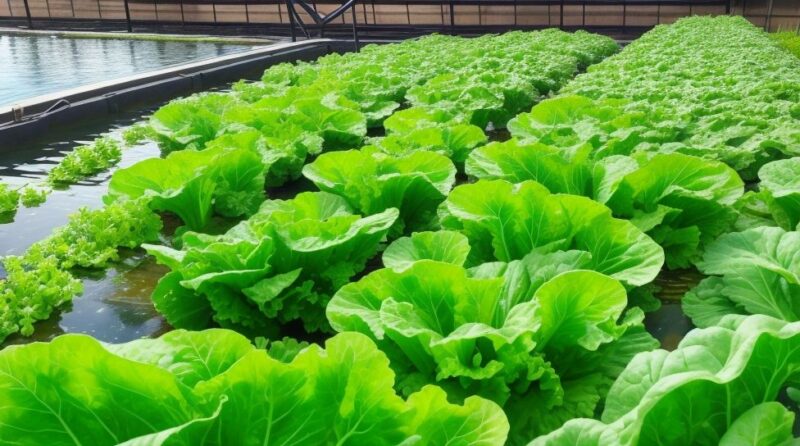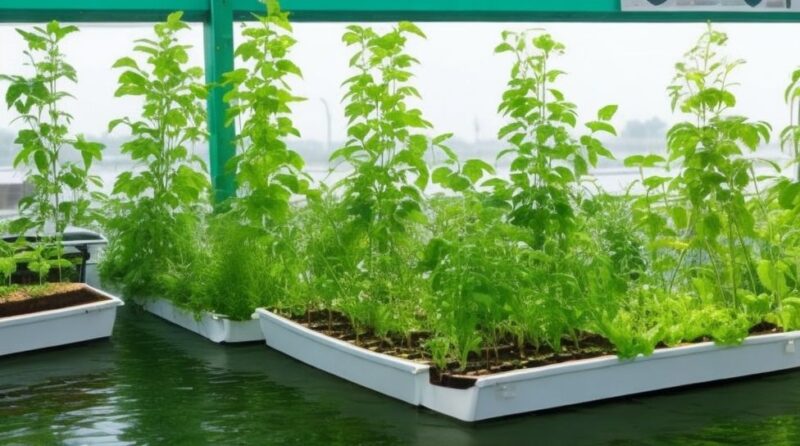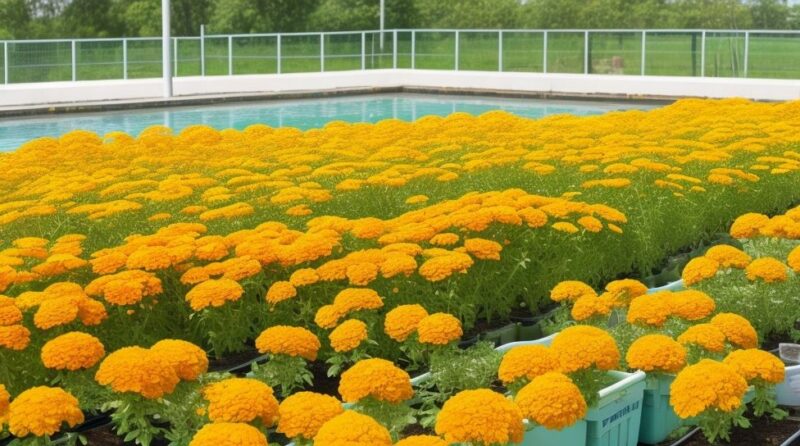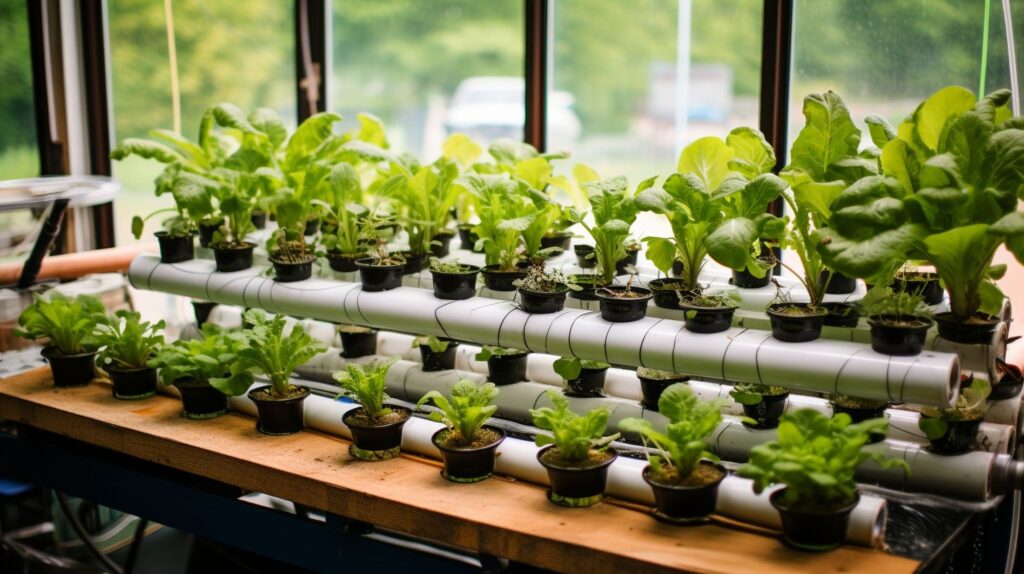This post may contain affiliate links and we may earn a small commission when you click on the links at no additional cost to you. As an Amazon Affiliate, we earn from qualifying purchases. You can read our full disclaimer here.
Welcome to the world of aquaponics, where fish and plants work together to create a sustainable and eco-friendly farming system. As you venture into this exciting field, one of the most crucial decisions you’ll face is selecting the right plants for your aquaponics setup. With the best plants for aquaponics, you can create a thriving and bountiful ecosystem that provides food and enjoyment for years to come. Here’s a guide to help you choose the best plants for your aquaponics system.
Key Takeaways:
- Choosing the right plants is crucial for a successful aquaponics system.
- Aquaponics offers numerous benefits, including reduced water usage and sustainable food production.
- You can grow a wide variety of crops in an aquaponics system, from leafy greens to fruiting plants.
- Consider factors like temperature requirements, nutrient needs, and growth habits when selecting plants for your aquaponics system.
- Leafy greens, herbs, fruit-bearing plants, root vegetables, flowering plants, and aquatic plants are all options for aquaponics.
Benefits of Aquaponics Gardening
If you’re looking for a sustainable and efficient way to grow plants, aquaponics gardening is an excellent choice. It involves cultivating both fish and plants in a closed system, where the waste produced by the fish provides nutrients to the plants, and the plants help to purify the water for the fish.
There are numerous benefits to aquaponics gardening, from faster growth rates and higher yields to reduced water usage and improved sustainability. Because the plants receive a constant supply of water and nutrients, they tend to grow more quickly and produce more fruit or vegetables than they would in traditional soil-based gardening methods.
In addition, aquaponics gardening allows you to grow a wide variety of crops, including leafy greens, herbs, fruiting plants, and even root vegetables. With the right system setup and plant selection, you can achieve a continuous harvest throughout the year, regardless of the season or weather conditions.
Benefits of Aquaponics Gardening:
- Fast growth rates and higher yields
- Reduced water usage
- Sustainable food production
- Ability to grow a wide variety of crops
- Continuous harvest throughout the year
Factors to Consider When Choosing Plants for Aquaponics
When selecting plants for your aquaponics system, it’s essential to consider several factors to ensure optimal growth and yield. Here are some essential considerations to keep in mind:
- Temperature requirements: Choose plants that thrive in the temperature range of your aquaponics system. For example, lettuce and spinach prefer cooler temperatures, while tomatoes and peppers require higher temperatures to grow successfully.
- Nutrient needs: Different plants have varying nutrient requirements. Select plants that can adapt to the nutrient levels provided by the system. Avoid plants that require excessive nutrients, as this can harm the fish.
- Growth habits: Some plants are bushy and require more space, while others grow vertically and require trellising or staking. Ensure that the plants you select are compatible with the available space in your aquaponics system.
- Compatibility with fish species: Choose plants that can thrive in the same water conditions as your fish and are not toxic to them. Avoid using plants that can damage the fish’s scales, fins, or gills.
- Water-based environment: Select plants that can grow in a water-based environment, such as those with shallow roots and those that can tolerate waterlogged conditions.
- Adaptability to fluctuating nutrient levels: The nutrient levels in an aquaponics system can fluctuate due to fish waste and plant uptake. Choose plants that can adapt to these changes and continue to thrive under varying conditions.
By considering these factors, you can choose plants that are ideal for your aquaponics system and ensure a healthy and productive harvest.
Leafy Greens: Perfect for Aquaponics
When it comes to selecting plants for your aquaponics system, leafy greens are a perfect choice. They are easy to grow, offer a high yield, and are packed with nutrients. Let’s take a look at some of the top leafy greens for aquaponics:
| Leafy Green | Growth Time | Optimal Temperature |
|---|---|---|
| Lettuce | 4-6 weeks | 60-68°F |
| Kale | 3-5 weeks | 60-70°F |
| Spinach | 4-6 weeks | 50-70°F |
| Swiss Chard | 3-5 weeks | 50-75°F |
As you can see, these leafy greens have relatively short growth times and can thrive in a range of temperatures. They also do well in aquaponic systems because they do not require high levels of nutrients or pH levels.

When growing leafy greens in your aquaponics system, it’s important to ensure they have adequate light and nutrients. You can use fish waste and other organic matter as a natural fertilizer, which also helps to maintain a healthy balance in your system.
In addition to these popular options, there are also many different varieties of leafy greens, such as arugula, mustard greens, and bok choy, that can be grown in aquaponics. Experiment with different varieties to find the ones that work best for your system and taste preferences.
Herbs: Fragrant and Flavorful in Aquaponics
Herbs are some of the most popular plants to grow in an aquaponics system. Not only do they add fragrance and flavor to your dishes, but they also offer potential health benefits. Here are some of the top herbs to consider for your aquaponics setup:
| Herb | Requirements | Tips for Success |
|---|---|---|
| Basil | Warm temperatures, ample light, and nutrient-rich water | Pinch off flowers regularly to encourage bushy growth. |
| Mint | Cool temperatures, well-draining soil, and slightly acidic water | Use a separate container to prevent mint from taking over your aquaponics system. |
| Parsley | Cool temperatures, moist soil, and nutrient-rich water | Trim regularly to promote new growth and prevent legginess. |
| Oregano | Warm temperatures, well-draining soil, and slightly alkaline water | Prune regularly to stimulate bushy growth and prevent the plant from becoming woody. |

These herbs are all relatively easy to grow in an aquaponics system, and they thrive in the nutrient-rich water that the fish provide. Experiment with different varieties to find the ones that grow best in your specific conditions.
Fruit-Bearing Plants in Aquaponics: A Sweet Success
If you’re looking to add some sweetness to your aquaponics setup, fruit-bearing plants are definitely worth considering. While they can be a bit more challenging to grow than other crops, the rewards can be deliciously satisfying.
Tomatoes are a popular choice for aquaponics enthusiasts, and for good reason. These juicy fruits can thrive in aquaponics and provide a bountiful harvest when grown in the right conditions. Peppers are another great option, adding some spice to your aquaponics garden.

For those with a sweet tooth, strawberries can be a great addition to your setup. These berries can be grown in both hanging baskets and towers, making them a versatile and space-saving option. Melons are another fruiting plant that can be successfully grown in aquaponics, although they require a bit more attention to ensure they thrive.
When it comes to growing fruiting plants in aquaponics, there are a few things to keep in mind. First, make sure you select plants that are suitable for your climate and growing conditions. Tomatoes and peppers, for example, prefer warmer temperatures and need plenty of light to produce fruit.
Second, pay close attention to nutrient levels in your system. Fruit-bearing plants require more nutrients than other crops, so you may need to supplement with additional fertilizer or fish feed.
Finally, be patient and attentive to your plants’ needs. Fruiting plants can take longer to mature and produce fruit than other crops, but with the right care and attention, you can enjoy a sweet and satisfying harvest.
Root Vegetables: Underground Treasures in Aquaponics
If you’re looking to add some variety to your aquaponics system, consider growing root vegetables. These plants are not only nutritious but also add a unique touch to your harvest. But before you start, there are a few things you should keep in mind.

Temperature Requirements
Root vegetables generally prefer cooler temperatures, so keep your aquaponics system at around 65-75°F (18-24°C) for optimal growth. Be sure to monitor the water and air temperature regularly, as fluctuations can affect your crop’s health.
Nutrient Needs
Root vegetables require a balanced nutrient ratio to thrive. Ideally, the pH level should be between 6.0 and 7.0, with a moderate level of nitrogen, phosphorus, and potassium. Monitor the nutrient levels regularly to ensure your plants are getting what they need.
Growth Habits
Some root vegetables, like carrots and beets, need more space to grow than others like radishes and turnips. To ensure your plants have enough room, be sure to space them out accordingly. They also prefer loose soil, so consider adding vermiculite or perlite to your growing medium to improve drainage.
Compatibility with Fish Species
While most root vegetables are compatible with a variety of fish species, keep in mind that some fish may like to explore and uproot your plants. Consider adding mesh covers or growing your crops in separate containers to prevent fish from disturbing the roots.
Recommended Root Vegetables for Aquaponics
Here are a few recommended root vegetables that you may want to consider growing in your aquaponics system:
| Root Vegetable | Optimal Temperature | Nutrient Requirements |
|---|---|---|
| Carrots | 60-70°F (16-21°C) | Low Nitrogen, High Phosphorus and Potassium |
| Radishes | 55-70°F (12-21°C) | Low to Medium Nitrogen, High Phosphorus and Potassium |
| Beets | 55-75°F (12-24°C) | Low Nitrogen, High Phosphorus and Potassium |
| Turnips | 55-65°F (12-18°C) | Low Nitrogen, High Phosphorus and Potassium |
These underground treasures are not only delicious but also relatively easy to grow in aquaponics. Just remember to provide the right growing conditions and monitor your plants regularly for optimal results.
Flowering Plants: Adding Beauty to Aquaponics
While aquaponics systems are primarily used for growing food, there’s no reason you can’t add some beauty to your setup with flowering plants. Not only do they add aesthetic appeal, but they can also provide companion planting benefits and attract pollinators to your closed system.
When choosing flowering plants for aquaponics, it’s important to consider their growth habits and nutrient requirements. Some popular options include marigolds, nasturtiums, and pansies.
| Flowering Plant | Benefits | Care Tips |
|---|---|---|
| Marigolds | Repel pests like aphids and whiteflies | Plant in well-draining soil and provide full sun |
| Nasturtiums | Attract beneficial insects like ladybugs and hoverflies | Plant in rich soil with partial shade |
| Pansies | Provide edible flowers that can add color and flavor to salads and other dishes | Plant in moist, well-drained soil with partial sun |

Be sure to take into account the size of your aquaponics setup when choosing flowering plants. Some varieties, like sunflowers, can grow quite tall and may not be suitable for smaller systems.
Overall, adding flowering plants to your aquaponics setup can be a fun way to enhance both the beauty and functionality of your system. Just be sure to choose varieties that are well-suited to the unique conditions of an aquatic environment, and you’re sure to enjoy a colorful and productive system.
Aquatic Plants: Enhancing the Aquaponics Ecosystem
Adding aquatic plants to your aquaponics system can help enhance the overall health and well-being of your system. These plants not only add aesthetic appeal, but they also play a crucial role in improving water quality and providing shade and shelter for fish.
Some popular aquatic plants for aquaponics include:
| Plant | Benefits |
|---|---|
| Watercress | High in vitamins A and C, iron, and other minerals; helps reduce algae growth |
| Water spinach | Excellent source of protein, vitamins, and minerals; helps control nitrate levels |
| Duckweed | High in protein and other nutrients; provides shade and cover for fish |
Incorporating these plants into your aquaponics system is easy. Simply place them in a floating raft or grow bed. They will help filter the water and remove excess nutrients, improving water quality and minimizing the risk of ammonia buildup. Additionally, they will provide shelter and shade for your fish, making them feel more secure and comfortable in their environment.

Overall, aquatic plants are a valuable addition to any aquaponics system. They play an important role in maintaining a healthy and balanced ecosystem, and can help you achieve optimal growth and yield in your fish and plants.
Conclusion
In conclusion, choosing the right plants is crucial for a successful aquaponics system. By selecting plants that thrive in a water-based environment and can adapt to fluctuating nutrient levels, you can ensure a bountiful harvest and a thriving ecosystem.
Leafy greens like lettuce, kale, spinach and Swiss chard are great options for aquaponics due to their quick growth and nutrient-rich properties. Herbs such as basil, mint, parsley, and oregano add fragrance and flavor to your aquaponics setup.
Fruit-bearing plants like tomatoes, peppers, strawberries, and melons can also be successfully grown in aquaponics, but require special attention to maximize yield and quality. Root vegetables like carrots, radishes, beets, and turnips are also suitable for aquaponics and offer continuous harvest potential.
You can also add beauty and functionality to your aquaponics system by incorporating flowering plants like marigolds, nasturtiums and pansies, as well as aquatic plants like watercress, water spinach, and duckweed.
Ultimately, the best plants for your aquaponics system will depend on your specific needs and preferences. We encourage you to continue your research and experimentation to find the perfect plants to suit your setup. Happy farming!




Pingback: How to Treat Aquaponics Water without Harming Fish and Plants